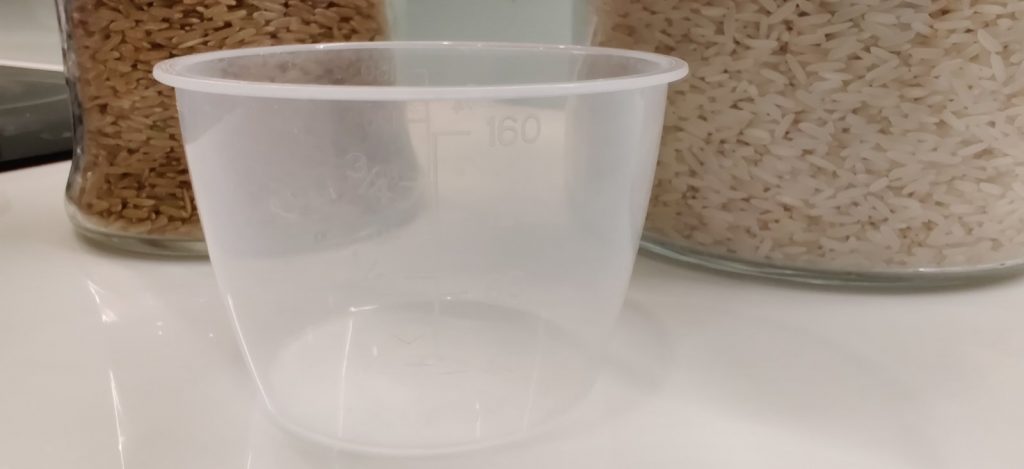
Let's Talk About Size
Selecting the correct size rice cooker for your needs is one of the most crucial things to do when purchasing a rice cooker.
Choose a cooker that is too small for you and you won't be able to make enough rice to satisfy your family and friend's (or even your) needs.
Choose a rice cooker that is too large for your needs means you end up having to cook too much rice for your needs.
You need to consider the rice you will be cooking and then check the inner bowl capacities below along with the actual physical dimensions of the rice cooker compared to the kitchen space you have available.
What Size Of Rice Cooker?
The first thing to consider is the size of the rice cooker you need. Rice cookers come in different sizes, these sizes are usually termed in cup sizes or litres. Yum Asia sells several different sized rice cookers – see below. All of these maximum capacities are for uncooked white rice, brown rice capacity is lower due to the fact it cooks/expands differently to white rice. Broadly speaking, the cup size of a rice cooker corresponds to how many people you are cooking for, however, it also depends on how much rice you usually cook per person. Often the rice measuring cup provided with rice cookers is 180ml. Rice is traditionally measured in terms of volume (ml) rather than weight (g). Please see below for more information on this.
Below is our capacity guide for the most popular rice cooker cup sizes. You can see the relative amounts of both uncooked and cooked rice that can be made for each capacity. The volumes show uncooked and cooked rice amounts so you also need to consider if you are going to be entertaining people or wanting to cook extra for lunches, if so, you should factor this into the size you want to buy.

Rice Cooker Size Guide
| Capacity | Uncooked White Rice | Cooked White Rice | Uncooked Brown Rice | Cooked Brown Rice | Multicook | Number Of People |
| 1 cup | 180ml | ~360ml | ~90ml | ~270ml | - | 1 |
| 2.5 cup | 450ml | ~1350ml | ~270ml | ~810ml | ~900ml | 1-2 |
| 3.5 cup | 630ml | ~1890ml | ~360ml | ~1260ml | ~1300ml | 1-3 |
| 4 cup | 720ml | ~2160ml | ~720ml | ~1440ml | ~1400ml | 1-4 |
| 5.5 cup | 1000ml | ~3000ml | ~720ml | ~2000ml | ~2100ml | 1-5 |
| 8 cup | 1500ml | ~4500ml | ~1000ml | ~3000ml | ~3300ml | 1-8 |
| 10 cup | 1800ml | ~5400ml | ~1500ml | ~3600ml | - | 1-10 |
So What Is The Rice Measuring Cup?
A measuring cup of rice does not correlate with a measuring cup we use in Western cooking where 1 cup equates to around 250ml.
The gō or cup is a traditional Japanese unit based on the ge which is equal to 10 shaku or 1⁄10 shō. Back in the year 1891 it was officially equated with 2401/13310 liters. The gō is the traditional amount used for a serving of rice and a cup of sake in Japanese cuisine.
Although the gō is no longer used as an official unit, 1-gō measuring cups or their 180ml metric equivalents are often included with modern premium rice cookers and is what are used with the rice cookers we sell at Yum Asia.
Keeping up? Okay almost there. So this is where we arrive at modern premium rice cooker measuring cups having a capacity of 180ml. The scale on these measuring cups goes up to 160ml but are actually 180ml. How is this you may ask? This is because you are supposed to fill the cup to the top (brim) with rice and level it off with chopsticks or a knife to get the full 180ml measurement.
Rice measuring cups may look slightly different with varying colours, shapes and markings but they are all usually of this standard size with levelling of to the top as being the accurate way to get the right rice volume. So when you fill with rice to get a full 180ml measuring cup. Don’t forget to go right to the brim and then level off the rice.
Why Use Volume And Not Weight To Measure Capacity?
Volume rather than weight of the rice is the preferred method when measuring rice. Why? This is because all rice does not weigh the same. When cooking rice it is crucial for the rice to water ratio to be exact for rice cooking perfection!
The weight varies depending on the grain type (length, thickness) and the moisture in the grains and can also vary between rice batch depending on how old or new the crop is. This makes things difficult to be consistent between cooking and batches of rice.
This means for example that a full measuring cup of new crop white jasmine rice may weigh very differently to a full measuring cup of aged basmati rice and so on. Basmati rice usually has less moisture content than jasmine rice and has a more elongated grain and so would weigh differently to each other.
By using volume in a fixed container size (the rice measuring cup) you can repeatedly measure similar volumes of rice grains. This is useful as rice cookers are calibrated to fixed rice to water volume ratios. The water variable in almost all rice cookers is set to the traditional 180ml of water measurement as being one rice measuring cup. The better you control these two variables the more accurately you can get consistent rice perfection!
Consider Rice Cooker Physical Sizes
Another factor to consider is the actual dimensions of the rice cooker bowl and steaming tray (if your rice cooker has it).
Dimensions
| RICE COOKER | INTERNAL BOWL SIZE | FULL BOWL CAPACITY | STEAM BASKET SIZE | UNIT SIZE FRONT TO BACK | UNIT WIDTH SIDE TO SIDE | UNIT HEIGHT FLOOR TO TOP |
| Tsuki (2.5 cup) | TBC | 1600ml | NA | 23.6cm | 27cm | 20cm |
| Panda (3.5 cup) | 11cm (h) x 15cm (w) | 2000ml | 3.7cm (h) x 14m (w) | 30cm | 22.5cm | 21cm |
| Fuji (4 cup) | 10cm (h) x 18.5cm (w) | 3000ml | 3.7cm (h) x 17cm (w) | 30cm | 30cm | 23cm |
| Kumo (5.5 cup) | 10.5cm (h) x 18.7cm (w) | 3000ml | 7cm (h) x 17.8cm (w) | 25cm | 25cm | 26cm |
| Sakura (8 cup) | 12.5cm (h) x 21cm (w) | 4400ml | 5cm (h) x 20.5cm (w) | 39cm | 29cm | 24cm |
| Bamboo (8 cup) | 12.5cm (h) x 21cm (w) | 4000ml | 5cm (h) x 20.5cm (w) | 37cm | 27cm | 24cm |
Try our rice cooker advisor tool
8 questions - takes 3 minutes to complete
FREQUENTLY ASKED QUESTIONS
Sometimes inner bowls are too small at their lower concave shape to mark a level line for 1 or ½ cup. We therefore explain in their user manuals how 1 or ½ cup of rice can be prepared.
Rice cups are traditionally 180ml (g) but please note that this is to the brim (top) of the rice cup. Whilst the scale of the rice cups goes to 160ml the cup’s capacity is actually 180ml or 180g when fully filled.

So when you fill with rice to get a full 180 mL measuring cup. Don’t forget to go right to the brim and then level off the rice.
You can use the in built Çompare feature of our website’. Every rice cooker has a compare icon you can click. Alternatively you can check our rice cooker comparison page here.
If you are still stuck you can get more guidance from our Choose a rice cooker page here
You can also use our rice cooker advisor tool above. It will ask you a series of questions and then based upon your answers will curate some rice cooker choices for you.
For Yum Asia models in Europe the manual is supplied in English, French, German, Italian and Spanish.
For Yum Asia models in the USA the manual is supplied in English, French and Spanish.
For Zojirushi models the language of the user manuals are English only
We supply many spare parts for our Yum Asia brand rice cookers such as inner bowls, inner lids. We also supply spare parts for Zojirushi from customers who have purchased their rice cookers from Yum Asia. Click here for our spare parts catalogue
Get answers to your questions
Try our help pages or get in touch
We work almost 24 hours, 7 days a week!
Our response usually takes up to 6 hours
